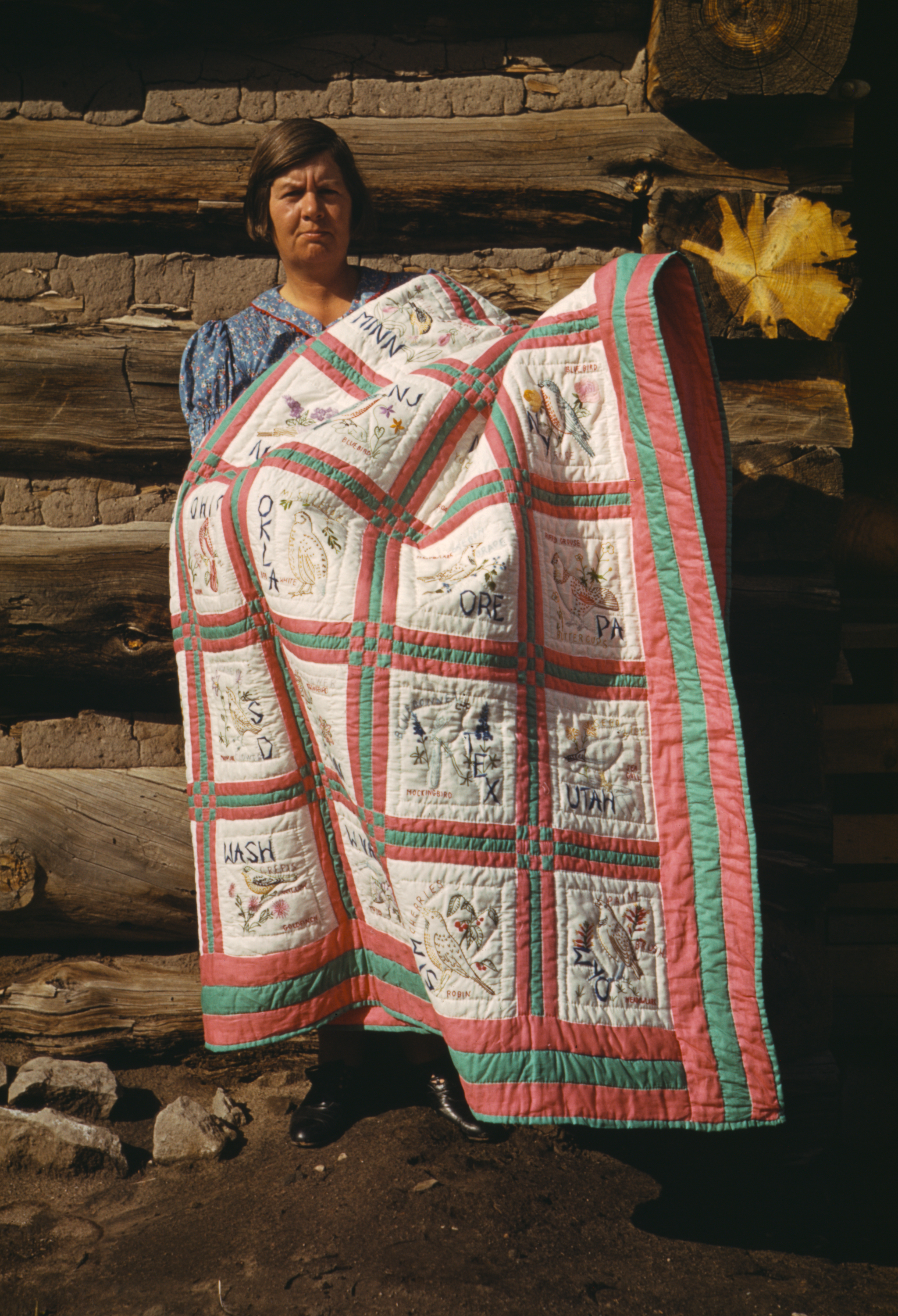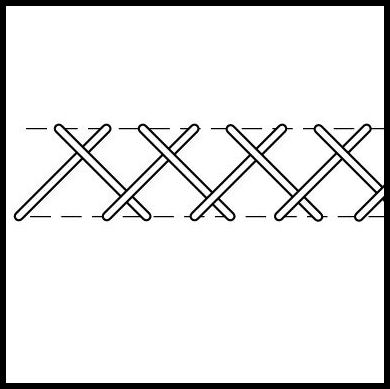|
Broderie Perse
Broderie perse (French for "Persian embroidery") is a style of appliqué which uses printed motifs from one fabric to create a design on a background fabric. It was popular in the late 18th century and early 19th centuries. The technique could be considered an early form of puzzle piecing. Description Broderie perse can be done with any printed fabric on any ground, but it originally was worked with Chintz type fabrics, often imported from India. Chintz typically has clearly defined, separated motifs, which were cut out and invisibly applied onto the ground fabric. Using motifs from the expensive, highly-prized fabric was a way to make the patterned fabric last longer. The typical intention was to create a scene from the motifs, but the decoration could also be random. Because the scale of the different motifs was not always considered, there might be a naive appearance to Broderie perse. Process Designs are cut out, leaving a small, even amount of fabric around the outside of ... [...More Info...] [...Related Items...] OR: [Wikipedia] [Google] [Baidu] |
Quilt LACMA M
A quilt is a multi-layered textile, traditionally composed of two or more layers of fabric or fiber. Commonly three layers are used with a filler material. These layers traditionally include a woven cloth top, a layer of batting or wadding, and a woven back combined using the techniques of quilting. This is the process of sewing on the face of the fabric, and not just the edges, to combine the three layers together to reinforce the material. Stitching patterns can be a decorative element. A single piece of fabric can be used for the top of a quilt (a "whole-cloth quilt"), but in many cases the top is created from smaller fabric pieces joined, or patchwork. The pattern and color of these pieces creates the design. Quilts may contain valuable historical information about their creators, "visualizing particular segments of history in tangible, textured ways". In the twenty-first century, quilts are frequently displayed as non-utilitarian works of art but historically quilts wer ... [...More Info...] [...Related Items...] OR: [Wikipedia] [Google] [Baidu] |
Appliqué
Appliqué is ornamental needlework in which pieces or patches of fabric in different shapes and patterns are sewn or stuck onto a larger piece to form a picture or pattern. It is commonly used as decoration, especially on garments. The technique is accomplished either by hand stitching or machine. Appliqué is commonly practised with textiles, but the term may be applied to similar techniques used on different materials. In the context of ceramics, for example, an appliqué is a separate piece of clay added to the primary work, generally for the purpose of decoration. The term originates from the Latin ''applicō'' "I apply" and subsequently from the French language, French ''appliquer'' "attach". History The term appliqué is derived from French and Latin verbs ''appliquer'' and ''applicare'', respectively, which both mean to join or attach. Like embroidery, it has a humble beginning. The technique was used as a way to strengthen worn areas of items or to patch holes that had ... [...More Info...] [...Related Items...] OR: [Wikipedia] [Google] [Baidu] |
Chintz
Chintz () is a woodblock printed, painted, stained or glazed calico textile that originated in Golconda (present day Hyderabad, India) in the 16th century. The cloth is printed with designs featuring flowers and other patterns in different colours, typically on a light, plain background. Name The name is derived from the , , meaning "spotted", "variegated", "speckled", or "sprayed". Since the 19th century, the term has also been used for the style of floral decoration developed in those calico textiles but then used more widely, for example on chintzware pottery and wallpaper. Chintz designs are derived from the style of Indian designs themselves reflecting Mughal art. A white base with floral and animal prints are its basic characteristics. Unglazed calico was traditionally called " cretonne". The word ''calico'' is derived from the name of the Indian city Calicut (''Kozhikkode'' in native Malayalam), to which it had a manufacturing association. In modern English, the wo ... [...More Info...] [...Related Items...] OR: [Wikipedia] [Google] [Baidu] |
Ladder Stitch
A ladder stitch, or mattress stitch, is a stitch which can be used to invisibly close seams from the outside of the garment or item. It is primarily used to close seams on stuffed items, such as pillows, mattresses, down coats or stuffed toys, where, after the stuffing is added, there is no access to the back of the fabric Textile is an umbrella term that includes various fiber-based materials, including fibers, yarns, filaments, threads, and different types of fabric. At first, the word "textiles" only referred to woven fabrics. However, weaving is no .... It can also be used to repair split seams on these items or garments, or to alter clothing. Surgical suturing Ladder stitching can also be used in surgery sutures to close an incision in the skin. In this context it is called a running subcuticular suture or running subcuticular closure. References Sewing stitches {{textile-arts-stub ... [...More Info...] [...Related Items...] OR: [Wikipedia] [Google] [Baidu] |
Herringbone Stitch
A herringbone stitch is a needlework stitch used in embroidery, knitting and crochet. It is so named as it resembles the bones extending from the spine of a herring fish. In knitting, it is a stitch that creates a fabric pattern closely resembling a herringbone pattern, or herringbone cloth. A knitted herringbone stitch creates a firm fabric "similar to a woven in appearance and elasticity". A heavyweight fabric can be made with variations of the herringbone stitch, such as the herringbone twist stitch, which can be worked in either one or two colours; both versions are suitable for experienced knitters. Cultural symbolism The herringbone stitch is used as one of the symbolic motifs in the traditional knitted Aran jumper, or "fisherman's sweater"; specifically, the tradition as it exists in the Channel Islands of Guernsey, Jersey and Filey. The herringbone pattern represents the "fisherman's catch and thus for success in one's career". See also *Basic knitted fabrics Basic ... [...More Info...] [...Related Items...] OR: [Wikipedia] [Google] [Baidu] |
Blanket Stitch
The blanket stitch is a stitch (textile arts), stitch used to reinforce the edge of thick materials. Depending on circumstances, it may also be called a ''cable stitch'' or a ''crochet stitch''. It is "a decorative stitch used to finish an hem, unhemmed blanket. The stitch can be seen on both sides of the blanket." History This stitch has long been both an application by hand and as a machine sewn stitch. When done by hand, it is sometimes considered a crochet stitch, used to join pieces together to make a blanket or other larger item. It is used in sewing leather pieces together, as traditionally done by indigenous American cultures, and even for weaving basket rims. The Whip stitch, whipstitch is also a type of surgical suturing stitch. When done by machine, it may be called a whip stitch or, sometimes, a Merrow Crochet Stitch, after the first sewing machine that was used to sew a blanket stitch. This machine was produced and patented by the Merrow Sewing Machine Company, Mer ... [...More Info...] [...Related Items...] OR: [Wikipedia] [Google] [Baidu] |
Rajah Quilt
The ''Rajah Quilt'' is a large quilt that was created by women convicts in 1841 whilst travelling from Woolwich, England, to Hobart, Australia, using materials organised by Lydia Irving of the convict ship subcommittee of the British Ladies Society for Promoting the Reformation of Female Prisoners. The quilt was presented to Jane Franklin. The quilt was sent back to Britain for Elizabeth Fry, the leader of the British Ladies Society. The quilt's provenance was then unclear until it was rediscovered in 1989. It is now held by the National Gallery of Australia. History Lydia Irving served on Elizabeth Fry's British Ladies Society for promoting the reformation of female prisoners convict ship sub-committee and she had a financial success when she persuaded the Navy board to fund "gifts" for the convicts. These basic items included knives, forks, aprons and notably, sewing materials.Amanda Phillips, ‘Irving, Lydia (1797–1893)’, Oxford Dictionary of National Biography, Oxford ... [...More Info...] [...Related Items...] OR: [Wikipedia] [Google] [Baidu] |
History Of Quilting
History is the systematic study of the past, focusing primarily on the human past. As an academic discipline, it analyses and interprets evidence to construct narratives about what happened and explain why it happened. Some theorists categorize history as a social science, while others see it as part of the humanities or consider it a hybrid discipline. Similar debates surround the purpose of history—for example, whether its main aim is theoretical, to uncover the truth, or practical, to learn lessons from the past. In a more general sense, the term ''history'' refers not to an academic field but to the past itself, times in the past, or to individual texts about the past. Historical research relies on primary and secondary sources to reconstruct past events and validate interpretations. Source criticism is used to evaluate these sources, assessing their authenticity, content, and reliability. Historians strive to integrate the perspectives of several sources to develop ... [...More Info...] [...Related Items...] OR: [Wikipedia] [Google] [Baidu] |






